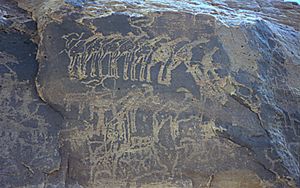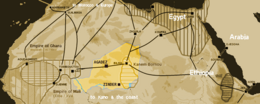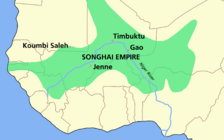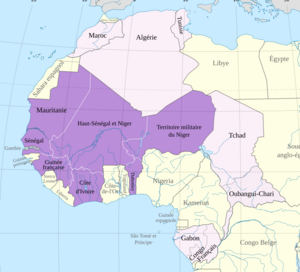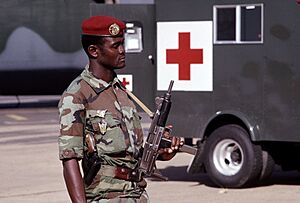History of Niger facts for kids
This is the story of Niger, a country in West Africa. It's a land with a very long and interesting past, stretching back millions of years!
Contents
Ancient Times in Niger
People have lived in the area we now call Niger for a very, very long time. Scientists have even found bones of early human ancestors, like Australopithecus bahrelghazali, in nearby Chad, dating back 2 to 3.5 million years!
Long ago, the northern part of Niger, which is now a dry desert, was actually a huge, green grassland. Imagine that! About 60,000 years ago, humans lived there. Later, around 7,000 BCE (that's Before Common Era), people started herding sheep and goats. They built large settlements and made pottery. Cattle arrived around 4,000 to 3,500 BCE. Amazing rock paintings in the Aïr Mountains show a land full of plants and animals, very different from today.
One discovery shows that the Sahara in northeast Niger was home to different groups of people. Some lived by shallow lakes, hunting and fishing, from about 7700–6200 BCE. They disappeared during a very dry period. When the climate became wetter again, like a savanna, and lakes returned, new groups appeared. They hunted, fished, and raised cattle. These people lived there until about 2500 BCE, when the area started to become the dry desert we see today.
As the Sahara dried up after 2000 BCE, most people moved to the south, near what is now the border with Nigeria, and to the southwest. Some settlements remained in the Aïr Mountains and around Lake Chad.
The Green Sahara
During a time called the "subpluvial era," North Africa had a very fertile climate. What is now the Sahara Desert was like a savanna, similar to the grasslands south of the desert today. Animals like elephants and giraffes roamed freely.
Historians describe the mountains of the central Sahara, like Tibesti and Hoggar, as being covered with forests of oak and walnut trees. Lower down, there were olive and juniper trees. Rivers flowed through the valleys, full of fish, and surrounded by grassy plains. It was a very different world!
Early Metal Use
Scientists have found signs that people might have started working with iron in a place called Termit Massif in eastern Niger as early as 1500 BCE. If true, this would be a very important discovery for understanding how metalworking spread in Africa. However, some older studies suggest that copper and iron technology spread much later, around the first Millennium CE. So, there's still some debate about how early metalworking began in Niger.
Niger's Ancient Trade
By at least 500 BCE, cities like Carthage and Egypt in North Africa were trading with West Africa. They exchanged salt, cloth, beads, and metal goods for gold, ivory, and slaves. Niger was an important stop on these trade routes, connecting the empires of the Sahel (the region south of the Sahara) with those around the Mediterranean Sea.
Trade continued into Roman times. Most of this trade was done by local people who knew the safe paths through the drying lands.
Recent discoveries in southwest Niger, at a place called Bura, show that an "Iron Age" culture existed there from the 3rd to the 13th century CE. This Bura culture seemed to cover the lower Niger River valley. More research is needed to understand how important this early civilization was in West Africa's history.
The Arrival of Camels
For a long time, people used chariots drawn by horses for travel and trade in the Sahara. However, horses weren't ideal for long desert journeys.
The first signs of domesticated camels in the region date back to the 3rd century CE. Camels were a game-changer! They allowed for much more regular travel across the vast Sahara Desert. But major trade routes didn't fully develop until Islam began to spread in West Africa in the 7th and 8th centuries.
Two main trade routes emerged. One went from modern Morocco across the western desert to the Niger Bend. The other went from modern Tunisia to the Lake Chad area. These routes were shorter and had important oases (water stops) that made them possible.
Niger's Empires
The Sultanate of Agadez was founded in 1449 and became a major trading and religious center. It was later taken over by the Songhai Empire in 1500.
In the late 1500s, trade routes across the Sahara helped spread the religion of Islam among different groups of people. However, in the 1600s, constant wars and severe droughts caused the population and economy of northern Niger to decline.
Niger was a key crossroads for trade. Many powerful empires, like Songhai, Mali, Gao, and Kanem-Bornu, as well as several Hausa states, controlled parts of the area.
In more recent centuries, the nomadic Tuareg formed large groups. They moved southward and sometimes joined with different Hausa states. They also clashed with the Fulani Empire of Sokoto, which had taken control of much of the Hausa land in the late 1700s. Eventually, the area became known as the Bornu Empire, which ended in 1893.
The Ottoman Empire (a large empire based in Turkey) also claimed control over the Agadez Region. This was the furthest point of their empire in Africa, and they held nominal control until the French arrived in the late 1800s.
Becoming a Colony
In the 1800s, Europeans started to explore the area. Famous explorers like Mungo Park (from Britain) and Heinrich Barth (from Germany) traveled through Niger, looking for the source of the Niger River.
France began to take control of Niger before 1900. However, some groups, especially the desert Tuareg, resisted for a long time. They were not fully brought under French control until 1922, when Niger officially became a French colony.
Niger's time as a colony was similar to other French territories in West Africa. France managed its West African colonies through a main governor in Dakar, Senegal, and individual governors in each territory, including Niger. Over time, the French constitution allowed for some power to be given to local advisory groups, and people in the territories were given a limited form of French citizenship.
Steps Towards Independence
Changes continued in 1956 and 1957, giving individual territories more self-government over things like education, health, and roads.
After France created its "Fifth Republic" in 1958, the French territories in West and Equatorial Africa were given a choice. They could vote to join the "French Community," which offered some self-government and was seen as a path to eventual independence.
In Niger, two main political groups competed in the elections. The Nigerien Progressive Party (PPN), led by Hamani Diori, wanted to stay in the French Community. The other group, called Sawaba (meaning "independence" in the Hausa language), led by Djibo Bakary, wanted to vote "no" and become fully independent right away.
The PPN won the vote, with about 358,000 votes for "yes" compared to 98,000 for "no." On December 18, 1958, Niger declared itself a republic within the French Community. This date is now celebrated as Republic Day, Niger's national holiday.
In 1958, Diori became the head of the temporary government, and then Prime Minister in 1959. Because he supported staying with France, Diori gained favor with the French. Between 1959 and 1960, the French government banned all other political parties except the PPN, making Niger a one-party state. Sawaba leaders had to leave the country.
Niger Becomes Independent
On July 11, 1960, France agreed to Niger becoming fully independent. On August 3, 1960, Niger officially declared its independence, with Hamani Diori as its Prime Minister. In November 1960, Diori was elected the first President of Niger.
For the first 14 years as an independent country, Niger was led by a single-party government under President Hamani Diori. During the 1960s, the education system grew, and there was some economic development and new industries.
Niger kept close ties with France. Diori allowed French companies to develop uranium mining in Arlit and supported France during the Algerian War of Independence. Niger's relationships with other African countries were mostly good, except for a border dispute with Dahomey (now Benin).
In the 1970s, Niger faced tough times. There were economic problems, severe droughts, and accusations that government officials were stealing food aid. People also accused Diori of mismanaging the country. These problems led to a military takeover that ended Diori's rule.
Diori was respected internationally for speaking up for African issues. But at home, his government faced many problems, including corruption. The government struggled to make needed changes or help people suffering from the severe Sahel drought in the early 1970s. Diori put down a coup attempt in 1963 and survived an assassination attempt in 1965, mostly planned by Djibo Bakary's group.
Diori used French advisors and troops to stay in power, even though students and unions protested against what they saw as French influence. His relationship with France became strained when his government expressed unhappiness with the amount of investment in uranium production.
Diori's political party, the PPN, was mainly controlled by a few leaders close to him. The party hadn't held a major meeting since 1959. The people elected to the assembly, often traditional leaders, had mostly ceremonial power. Tensions between different ethnic groups also grew during Diori's time. The government was mostly made up of people from the Djerma, Songhai, and Maouri ethnic groups from the west of the country. This was the same group the French had favored during colonial rule. Even though the Hausa people made up over 40% of Niger's population, they were not included in the main leadership.
Widespread unrest followed claims that some government ministers were stealing food aid. People also accused Diori of taking too much power for himself. He limited government jobs to people from his own ethnic group, family, and close friends. He also declared himself the minister of foreign and defense affairs.
From 1974 to 1990
On April 15, 1974, Lieutenant Colonel Seyni Kountché led a military takeover that ended Diori's rule. Diori was put in prison until 1980 and then kept under house arrest until he died in 1989. The military government that followed, even though it faced its own coup attempts, lasted until 1993. This was a time of some economic growth, but the military government allowed little freedom of speech and sometimes imprisoned or killed people without fair trials.
The first presidential election in Niger was held in February 1993, and it was the first time multiple political parties could compete, 33 years after independence. The first local elections didn't happen until 2007.
When Kountché died in November 1987, his cousin, Colonel Ali Saibou, took over. Saibou made some of Niger's laws and policies more open and created a new constitution. He released political prisoners, including Diori and his old rival, Djibo Bakary. However, President Saibou's attempts to control political changes failed. Unions and students demanded a multi-party democratic system. Saibou's government agreed to these demands by the end of 1990.
New political parties and groups formed. A "National Conference" was held in July 1991 to prepare for a new constitution and fair elections. The discussions were often heated, but under the leadership of Professor André Salifou, they agreed on how to set up a temporary government.
The 1990s
A temporary government was put in place in November 1991 to manage the country until a new democratic system was ready in April 1993. Even though the economy struggled during this time, there were important achievements. A new constitution was approved by the people, important laws were passed, and several free and fair elections were held peacefully. Freedom of the press also grew, with many new independent newspapers appearing.
In 1993, Mahamane Ousmane, from the Democratic and Social Convention (CDS) party, won the presidential election with the help of other parties. However, the agreement between these parties broke down in 1994, causing the government to become stuck. Ousmane dissolved the parliament and called for new elections. But the National Movement for the Development of Society (MNSD) party won the most seats, so Ousmane had to appoint Hama Amadou from the MNSD as Prime Minister.
Since 1990, groups of Tuareg and Toubou people had been leading a rebellion, saying they weren't getting enough attention and resources from the government. In April 1995, the government signed peace agreements with these groups. The government agreed to let some former rebels join the military and, with help from France, assist others in returning to normal civilian life.
The constant disagreements between the President and the Prime Minister gave Colonel Ibrahim Baré Maïnassara a reason to overthrow the government on January 27, 1996. He ended the Third Republic and removed Niger's first democratically elected president. Baré led a military government for six months and then had experts write a new constitution for a "Fourth Republic" in May 1996.
Baré held a presidential election in June 1996. He ran against four other candidates, including Ousmane. Before all the votes were counted, Baré dissolved the national election committee and appointed a new one, which declared him the winner with over 50% of the votes.
When his efforts to justify his takeover and questionable election failed to convince other countries to restart economic aid, Baré ignored international rules and sought money from Libya. His government repeatedly violated basic civil liberties. Opposition leaders were imprisoned, journalists were often arrested, beaten, and deported, and independent media offices were looted and burned without anyone being punished.
In April 1999, Baré was killed in another coup led by Major Daouda Malam Wanké. Wanké set up a temporary "National Reconciliation Council" to create a new constitution for a "Fifth Republic," which would have a system similar to France's, with both a president and a prime minister. International observers said the votes were generally free and fair. The people of Niger approved the new constitution in July 1999 and held elections for parliament and president in October and November 1999. Tandja Mamadou, leading a coalition of parties, won the presidency. The military government handed power back to civilian rule in December 1999.
The 2000s
In July 2004, Niger held local elections across the country as part of a plan to give more power to local governments. About 3,700 people were elected to new local councils in 265 new towns and villages. The ruling MNSD party won more positions than any other party, but opposition parties also gained a lot of ground.
In November and December 2004, Niger held presidential and parliamentary elections. Mamadou Tandja was elected for his second five-year term as president, winning 65% of the vote. International observers said the election was generally free and fair. This was an important moment for Niger's young democracy, as it was the first time a democratically elected president was re-elected.
In the 2004 parliamentary elections, a group of parties supporting Tandja won 88 out of 113 seats in the National Assembly.
A new conflict, called the Second Tuareg insurgency in Niger, began in 2007. A new group, the Mouvement des Nigeriens pour la Justice (MNJ), emerged. This group, mostly Tuareg, made demands related to development in the northern part of the country. They attacked military bases and other facilities and placed landmines in the north. This insecurity badly hurt Niger's tourism industry and stopped new investments in mining and oil.
Algeria helped to negotiate a peace deal in Mali in August 2008, but a rebel group broke it. Niger saw heavy fighting and problems with uranium production in the northern mountains. A peace deal, helped by Libya and a split among the rebels, led to a ceasefire and amnesty in May 2009.
On May 26, 2009, President Tandja dissolved parliament. This happened after the country's highest court ruled against his plans to hold a vote to allow him a third term in office. The constitution said a new parliament had to be elected within three months. This started a political struggle between Tandja, who wanted to stay in power beyond his two-term limit, and his opponents, who demanded he step down in December 2009. This led to a 2009 Nigerien constitutional crisis. The military took over the country in February 2010, and President Tandja was put in prison, accused of corruption.
The military kept its promise to return the country to democratic civilian rule. A vote on a new constitution and national elections were held. A presidential election took place on January 31, 2011. Since no one won clearly, a second round of elections was held on March 12, 2011. Mahamadou Issoufou of the Nigerien Party for Democracy and Socialism was elected president. A parliamentary election was held at the same time.
An attempted coup happened on the night of March 30-31, 2021, just a few days before the new president, Mohamed Bazoum, was to take office. On April 2, 2021, Bazoum officially became president. However, he was removed from office on July 26, 2023, after another coup led by members of the presidential guard and the armed forces. These military leaders then announced the formation of a "National Council for the Safeguard of the Homeland." The next day, Bazoum's foreign minister, Hassoumi Massoudou, declared himself the acting head of state and called for the coup to be stopped. On July 28, General Abdourahamane Tchiani declared himself the de facto (actual) president of the country.
See also
 In Spanish: Historia de Níger para niños
In Spanish: Historia de Níger para niños
- History of Niamey (the capital and largest city)
- List of heads of government of Niger
- List of heads of state of Niger
- Politics of Niger
- Green Sahara


